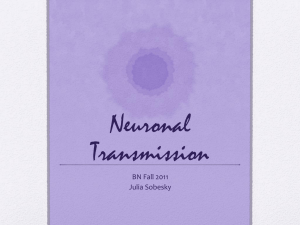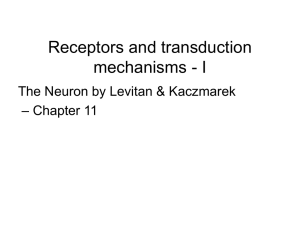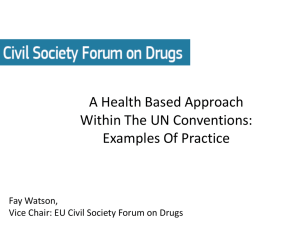Eliot Gardner, Ph.D. - Nysam
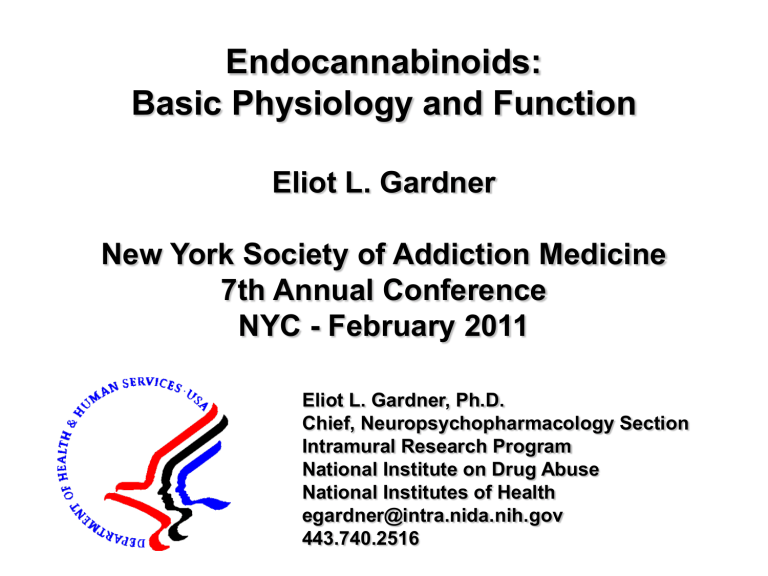
Endocannabinoids:
Basic Physiology and Function
Eliot L. Gardner
New York Society of Addiction Medicine
7th Annual Conference
NYC - February 2011
Eliot L. Gardner, Ph.D.
Chief, Neuropsychopharmacology Section
Intramural Research Program
National Institute on Drug Abuse
National Institutes of Health egardner@intra.nida.nih.gov
443.740.2516
Cannabis
Many species exist: Cannabis Sativa (European
• Many species exist: Cannabis Sativa (Europe), Cannabis Indica (India) plant), Cannabis indica (Indian plant) and Cannabis and Cannabis ruderalis (Siberia and central Asia)
ruderalis (Siberia and central Asia plant)
• 460 known chemical constituents of cannabis
460 known chemical constituents of cannabis
• Δ 9
66 constituents have a cannabinoid structure
• Δ 9 Δ 9 -THC most important constituent: principal psychoactive component of cannabis
Era of Cannabis Research: 200-1940
● Circa 200 AD: Therapeutic properties of cannabis described in
Chinese pharmacopoeia
● 1838-1840: Sir W.B. O’Shaughnessy methodically assesses medicinal properties of cannabis, and publishes findings
● 1899: Wood et al. isolate cannabinol from cannabis resin
● 1932: Cahn elucidates part of the structure of cannabinol
● 1940: Todd et al. and Adams et al. simultaneously elucidate the full structure of cannabinol and successfully synthesize it
Era of Cannabinoid Research: 1960-1994
● 1960: Mechoulam (Hebrew University) identifies THC as the principal psychoactive component of cannabis
● 1964: Gaoni and Mechoulam (Hebrew University) elucidate the chemical structure of THC
● 1970-1990: Cannabinoid pharmacology is thoroughly studied
● 1985: Gardner shows cannabinoid-opioid interaction in brain
● 1986: Gardner shows THC activates brain-reward systems
● 1988: Howlett’s group finds specific THC binding sites in brain
● 1990: Matsuda et al. clone the CB1 receptor
● 1992: Mechoulam’s group (Hebrew University) in collaboration with Pertwee’s group (Scotland) identify the first endocannabinoid – Mechoulam names it “anandamide” from the Sanskrit word “anand” meaning “bliss”
● 1993: Munro et al. clone the CB2 receptor
Era of Endocannabinoid Research: 1994-2000
● 1994: Scientists at Sanofi Recherche (France) develop the first CB1 receptor antagonist – SR141716A (Rimonabant)
● 1995: Mechoulam (Hebrew University) isolates and identifies the second endocannabinoid – 2-Arachidonoylglycerol (2-AG)
● 1996: Cravatt et al. (Scripps) clone the first endocannabinoid degrading enzyme – fatty acid amide hydrolase (FAAH)
● 1998: House of Lords report on medical cannabis
● 1998: Di Marzo et al. propose interactions between endocannabinoids and vanilloid receptors
● 1999: Zygmunt et al. and Smart et al. show that anandamide activates vanilloid receptors
Current Endocannabinoid Research: 2000-
● 2003: Bisogno et al. clone the first endocannabinoid biosynthesizing enzymes
● 2005: Pertwee et al. (Scotland) discovers an allosteric site on
CB1 receptors
● 2005: Sativex ® approved for sale in Canada
● 2010: Gardner shows psychoactive (and potentially therapeutic) effects of cannabidiol
● ????: Discovery of new cannabinoid receptors
● ????: Discovery of new endocannabinoids
● ????: Discovery of new endocannabinoid enzymes
● ????: Cloning of new endocannabinoid transporters
● ????: Discovery of new cannabinoid-based therapies
What is a cannabinoid?
• Initially, compounds extracted by Cannabis spp producing characteristic psychoactivity
• Later, compounds with a characteristic terpenoid structure
• Currently, most any compound that produces cannabinoid psychoactivity, natural or synthetic
• Occasionally, just compounds that will interact with cannabinoid receptors
Natural cannabinoids
Representative cannabinoids
Classical cannabinoids Non-classical cannabinoid Aminoalkylindole
CB
1 antagonists
Endocannabinoids
HO
HN
O
Anandamide
HO
HO
O
O
2-Arachidonoylglycerol
HO
HO
O
Noladin ether
HO
HO
HN
O
N-Arachidonoyldopamine
NH
2
O
O
Virodhamine
Cannabinoid CB1 and CB2 Receptors
Characteristics of CB1 and CB2 Receptors
• Both densely distributed throughout the body
• CB1 highly enriched in central nervous system
• Located on axon terminals
• Mediate retrograde signaling (Dendrite → Axon)
• G-protein coupled
• CB2 highly enriched in periphery
– Especially in immune system
• CB2 also in brain and CNS
– Fewer than CB1; ~ Same density as μ opioid
– Nonetheless, CB2s modulate neural signaling
CB1 and CB2 Receptors not the only
Receptors Activated by Cannabinoids
• Cannabidiol (CBD) receptors
• Transient Receptor Potential Cation V1 receptors (TRPV1; Capsaicin receptors)
• G-coupled Protein Receptor 55 (GPR55)
• G-coupled Protein Receptor 119 (GPR119)
• Peroxisome Proliferator-Activated receptors
(PPARs)
• Others
CB1-Mediated Signal Transduction
NA+/H+ exchanger
CB
1
ATP
AC
AMPc
MAPK
PKA
Gene expression
K +
AA
Ca 2+
Guindon, Beaulieu and Hohmann (2009)
Pharmacology of the cannabinoid system, IASP Press
Mouse
CB
1
localization
Monkey
H.-C. Lu
• Antibodies
• Distinctive pattern of distribution
• Cortex, hippocampus, basal ganglia, SN, cerebellum
• Low in thalamus and most of brainstem
Eggan S. and Lewis D. Cerebral
Cortex 2007; 17:175
CB
1 receptor localization (hippocampus) mRNA protein
István Katona
•In the forebrain, the majority of CB
1 protein arises from a minority of interneuons (CCK + GABAergic)
CB
1 receptor localization (hippocampus) protein EM
Jim Wager-Miller
•CB
1 heavily expressed on some axons & terminals
István Katona
CB
1 receptor localization (VTA)
István Katona
•CB
1 expressed on two populations of terminals
•Functionally, multiple VTA synapses are modulated by cannabinoids
CB
1
agonists modulate neurotransmission
• The signaling pathways of CB1 suggest cannabinoids might decrease neurotransmission:
•Inhibition of calcium channel, adenylyl cyclase
•Activation of potassium channels, MAP kinase
• Appropriate localization of the receptors
• Multiple studies show inhibition of neurotransmitter release
CB
1
agonists modulate neurotransmission
V c
Typical experiment:
•Hippocampal slices
•Patch clamp recording
•Bath apply drugs stimulate record
Measure GABAergic currents in CA1
Hájos
CB
1 receptor activation inhibits evoked GABA IPSC’s
CB
1
receptor summary
• Abundantly expressed throughout the brain
• Majority on axons and synaptic terminals
• Primarily G i/o
• CB
1 coupled (not only!) activation inhibits synaptic transmission
Endogenous cannabinoids
Receptors suggest endogenous ligands
Two main families identified
Both arachidonic acid derivatives
Precursors in membranes
“Made on demand”
Amides (anandamide)
Esters (2-AG)
• Significant differences
– Routes of synthesis
– Mode of degradation
(FAAH vs MAGL)
– Efficacy
CB1 agonist efficacy is variable
Many studies have found 2-AG to be more efficacious than anandamide (or
THC) at CB1 (GIRK activation in oocytes shown here)
2-AG
MEA
THC
Luk, et al, 2004
eCB summary
• Acyl ethanolamides (diverse; anandamide, AEA)
• More promiscuous --- many targets
• Acyl glycerol esters (2-AG)
• Both are “Made on demand”
• 2-AG ~100x more bulk levels, similar “signaling”(?)
• Differing efficacies
• Metabolic diversity, with “core” pathways
What are the physiological effects of eCB’s on neuronal activity?
• Exogenous cannabinoids inhibit neurotransmission
• eCB’s are synthesized following increases in intracellular calcium and/or activation of G q/11 linked receptors
-
• Might eCB’s synthesized in this fashion modulate neurotransmission?
• Yes
•Transient effects
•Long lasting effects
Six Types of eCB-Mediated Synaptic
Plasticity Have Been Clearly Identified
• Depolarization-induced suppression of inhibition
• Depolarization-induced suppression of excitation
• Metabotropic-induced suppression of inhibition
• Metabotropic-induced suppression of excitation
• Long-Term Depression (LTD)
• Slow self-inhibition (SSI)
• Additional types are being constantly discovered
Important Take-Home Messages
• Endocannabinoids are neurotransmitters
• Cannabinoids (e.g., THC) modulate neural activity
• Endocannabinoids are involved in synaptic remodeling
• Cannabinoids (e.g., THC) can modulate synaptic remodeling
• Depending upon the specific CNS circuits involved, cannabinoids can have a host of actions on brain, cognition, and behavior (some beneficial, some not)
Cannabinoids and pain
● central
● spinal
● periphery
Peripheral and spinal localization of cannabinoid receptors
Ständer et coll. J Dermatol Sci 2005 Hohmann & Herkenham
Neuroscience 1999
Bridges et coll.
Neuroscience 2003
Farquhar-Smith et coll.
Mol Cell Neurosci 2000
AEA
NAPE-
PLD ?
NAPE
NAT
Presynaptic neuron
CB
1
2-AG MGL
Neurotransmitter vesicles
ET
Ca 2+
DAGL ET
2-AG
DAG
PLC
Phospholipid
NAPE-
AEA
PLD ?
NAPE
NAT ?
AA
COX
PG
Postsynaptic neuron
Guindon et al., (2009) Pharmacology of the cannabinoid system, IASP Press
Evaluation of nociceptive behavior in the formalin test
Normal behaviour
Behaviours* Observations Scoring system**
Injected paw can support the weight of the animal.
Time spent in this category
0
Pain behaviour (1)
Injected paw has little or no weight on it. 0
Pain behaviour (2)
Injection 50 µL Formaline 2.5 %
NaCl 0,9%
1.2
1
0.8
0.6
0.4
0.2
0
0 5 10 15 20 25 30 35 40 45 50 55 60
Time (min)
Pain behaviour (3)
* The same behaviours are observed with the hind paw.
Injected paw is elevated, not in contact with any surface.
Injected paw is licked, bitten or shaken.
1
2
** Watson et al.
(1997)
Peripheral Antinociceptive Effects
NaCl 0.9 %
1.2
1
0.8
0.6
0.4
0.2
0
0
†
Anandamide 0.1 µg Ibuprofen 2 µg Rofecoxib 2 µg
#
5 10 15 20 25 30
Time (min)
35 40 45 50 55 60
† AUC (0-15) P < 0.05 and # AUC (15-60) P < 0.001 for analgesics vs NaCl 0.9 %
ipsilateral
1, 2
1
0, 8
0, 6
0, 4
0, 2
0
0 5 10 15 20 25 30 35 40 45 50 55 60 contralateral
5
10
15
25
20
Synergistic effect of anandamide + ibuprofen
Anandamide
Ibuprofen
Mix (1:10)
0.2
0.15
Anandamide
Ibuprofen
Mix 1:10
Add 1:10
0.1
0.05
0
0 0.005
0.01
0.015
0.02
Dose Anandamide (µg)
0
-4 -3 -2 -1
Log dose (µg)
0
Guindon et al. (2006) Pain 121: 85-93
1
5
10
15
25
20
Synergistic effect of anandamide + rofecoxib
Anandamide
Rofecoxib
Mix (1:10)
0.2
Anandamide
Rofecoxib
Mix 1:10
Add 1:10
0.15
0.1
0.05
0
0 0.005
0.01
Dose Anandamide (µg)
0.015
0
-4 -3 -2 -1
Log dose (µg)
0
Guindon et al. (2006) European Journal of Pharmacology 550: 58-77
1
Objectives of 2-AG, JZL184 and URB602 study
Compare the peripheral antinociceptive effects of 2-AG,
JZL184, URB602 and their combination in the formalin test
Study the mechanisms by which JZL184 and URB602 produce their effects using specific
CB and CB
2 receptor antagonists
1
Peripheral Antinociceptive Effects
NaCl 0.9%
#
URB602 500 µg
1.2
1
0.8
0.6
0.4
0.2
0
†
0 5 10 15 20 25 30 35 40 45 50 55 60
Time (min)
† P < 0.001 and # P < 0.001 for URB602 (500 µg) vs NaCl 0.9 %
ipsilateral
1.2
1
0.8
0.6
0.4
0.2
0
0 5 10 15 20 25 30 35 40 45 50 55 60
contralateral
Peripheral Antinociceptive Effects
1
0,8
0,6
0,4
†
Vehicle JZL184 300 microg
#
1
0,8
0,6
0,4
0,2
0
0 5 10 15 20 25 30 35 40 45 50 55 60 contralateral
0,2
0
0 5 10 15 20 25 30 35 40 45 50 55 60
Time (min)
† P < 0.001 and # P < 0.001 for JZL184 ( (300 µg) vs NaCl 0.9 %
ipsilateral
16
20
JZL184 with cannabinoid antagonists
Inflammatory Phase
12
8
*
4
0
Vehicle JZL184 10µg AM251 80µg AM251 + JZL184 AM630 25µg AM630 + JZL184
* P < 0.001 for JZL184 (10 µg) vs Vehicle
12
8
20
URB602 with cannabinoid antagonists
Inflammatory Phase
16
*
4
0
NaCl 0.9 % URB602 70µg AM251
Guindon et al. (2006) Brithish Journal of Pharmacology 150: 693-701
URB602
AM630+
URB602
* P < 0.001 for URB602 (70 µg) vs NaCl 0.9 %
Conclusions
JZL184, URB602, 2-AG and their combination reduce nociceptive behavior when given locally
JZL184 is more potent than URB602 when given alone or combined with 2-AG
Antinociceptive effects of JZL184 and
URB602 are inhibited by AM251 and
AM630
Cannabinoids and Addiction
There is now an extensive published literature showing antiaddiction efficacy for cannabinoid ligands
• Gardner EL. Endocannabinoid signaling system and brain reward: emphasis on dopamine. Pharmacol Biochem Behav 81:263-284, 2005
• De Vries TJ & Schoffelmeer AN. Cannabinoid CB1 receptors control conditioned drug seeking. Trends Pharmacol Sci 26:420-426, 2005
• Cohen C et al. CB1 receptor antagonists for the treatment of nicotine addiction.
Pharmacol Biochem Behav 81:387-395, 2005
• Maldonado R et al. Involvement of the endocannabinoid system in drug addiction.
Trends Neurosci 29:225-232, 2006
•
Basavarajappa BS. The endocannabinoid signaling system: a potential target for next-generation therapeutics for alcoholism. Mini-Revs Med Chem 7:769-779, 2007
• Fattore L et al. Endocannabinoid regulation of relapse mechanisms. Pharmacol Res
56:418-427, 2007
• Scherma M et al. The endocannabinoid system: a new molecular target for treatment of tobacco addiction. CNS & Neurol Disorders - Drug Targets 7:468-481, 2008
• Paralaro D & Rubino T. The role of the endogenous cannabinoid system in drug addiction. Drug News Perspect 21:149-157, 2008
CB1 Antagonist-Induced Attenuation of Cocaine-Enhanced
Brain Stimulation Reward
CB1 Antagonist-Induced Attenuation of Cocaine-Enhanced
Brain Stimulation Reward
CB1 Antagonism Does Not Affect Motoric Ability
Pump
Cocaine
?
PR Schedule
Reward Work Demand
(# Infusion) (# Lever Press)
1 1
2 2
3 4
4 6
5 9
14 77
15 95
16 118
…. ….
1000
800
600
400
1600
A After Vehicle
1400
1200
Cocaine = 0.5 mg/kg/infusion
Self-Administer i.v. Cocaine – Representative Animal
0 20 40
(Progressive-Ratio Model)
60 80 100 120 140 160
Time (min)
800
600
400
200
0
0
1600
A After Vehicle
1400
1200
1000
20 40
Cocaine = 0.5 mg/kg/infusion
60 80 100 120 140 160
Time (min)
1600
B
1400
1200
1000
800
600
400
200
0
0 20
After AM 251 (1 mg/kg)
40
Cocaine = 0.5 mg/kg/infusion
120 140 160 60 80 100
Time (min)
1600
B
1400
1200
1000
800
600
400
200
0
0 20
After AM 251 (1 mg/kg)
40
Cocaine = 0.5 mg/kg/infusion
120 140 160 60 80 100
Time (min)
CB1 Antagonist-Induced Attenuation of Incentive Motivation to
Self-Administer i.v. Cocaine (Progressive-Ratio Model)
30
20
10
0
70
AM 251
AM251 (Original Break-Point)
60
50
40
*
***
0 1 3
AM 251 (mg/kg, i.p.)
10
120
AM251 (% Change in Break-Point)
100
80
60
40
20
0
*
*
***
0 1 3
AM 251 (mg/kg, i.p.)
10
100
SR141716A
80
60
40
20
0
*
*
0 0.3
1
SR141716A (mg/kg, i.p.)
2
*
60
40
20
0
120
100
80
*
*
*
0 0.3
1
SR141716A (mg/kg, i.p.)
2
CB1 Receptor Antagonism Dose-Dependently Attenuates
Relapse to Cocaine-Seeking Behavior (Reinstatement Model)
CB1 Receptor Antagonism Does Not Attenuate Relapse to
Non-Drug Reward-Seeking Behavior (Reinstatement Model)
CB1 Receptor Antagonist Micro-Injected Into Nucleus Accumbens
Attenuates Cocaine-Seeking Behavior (Reinstatement Model)
CB1 Receptor Antagonism By Itself Does Not Produce
Drug-Seeking Behavior (Reinstatement Model)
CB1 Receptor Antagonism Markedly Attenuates Cocaine-
Enhanced Nucleus Accumbens Glutamate (Brain Microdialysis)
CB1 Receptor Antagonism Markedly Attenuates Cocaine
Sensitization
CB1 Receptor Gene-Deletion (CB1 Gene Knock-Out) Abolishes
Cocaine’s Psychostimulant Effects
CB1 Receptor Gene-Deletion (CB1 Gene Knock-Out) Abolishes
Cocaine-Enhanced Nucleus Accumbens Dopamine (Dialysis)
CB1 Receptor Gene-Deletion (CB1 Gene KO) Attenuates
Evoked Nucleus Accumbens Dopamine Release (Voltammetry)
CB1 Receptor Gene-Deletion (CB1 Gene KO) Attenuates
Evoked Nucleus Accumbens Dopamine Release (Voltammetry)
CB1 Antagonist SR141716 (Rimonabant) By Itself Markedly
Inhibits Nucleus Accumbens Dopamine (Brain Microdialysis)
Other CB1 Receptor Antagonists (Either Neutral Antagonists or
Inverse Agonists) Do Not Do This !!
Caveats Regarding Development of
Cannabinoid Agonists as Potential
Pharmacotherapeutic Agents
• CB1 and CB2 receptors are ubiquitous throughout the body – Potential for numerous side effects
• Some cannabinoid ligands have poor bioavailability
• CB1 receptor agonists have addictive potential
Potential Cannabinoid Therapies - Tools
• Endocannab Uptake Inhibitors – AM404, UCM707, AM1172
• FAAH Inhibitors – URB597, OL135, BMS1, SA47, PF750
• MAGL Inhibitors – URB602, OMDM169, JZL184
• Dual CB1/CB2 Agonists – WIN55512, CP55940, HU210
• Anandamide Analogues – Methanandamide, Metfluoroanand.
• Selective CB1 Agonists – ACEA, ACCP
• Selective CB2 Agonists – HU308, JWH015, JWH133, AM1241
• 2-AG Synthesis Inhibitors – O3640, O3891, OMDM188, O5596
• CB1 Antagonists/Inverse Agonists – SR141716A, AM251
• CB1 Neutral Antagonists – AM4113, PIMSR1
• CB2 Antagonists/Inverse Agonists – SR144528, AM630
• CB1 Receptor Allosteric Modulators – ORG27596, ORG29647
Potential Cannabinoid Therapies – Clinical Indications
• Diseases of Energy Metab.
– Appetite Dysregulation
– Obesity
– Dyslipidemia
– Periph Energy Metab Dysreg
– Cachexia
– Anorexia
– Type 2 Diabetes
• Pain
– Somatosensory Pain
– Neuropathic Pain
• Inflammation
• CNS Disorders
– Closed Head Brain Trauma
– Neurotoxicity
– Stroke
– Spinal Cord Injury
– Multiple Sclerosis
– Parkinson’s Disease
– Huntington’s Disease
– Tourette’s Syndrome
– Tardive Dyskinesia
– Dystonia
– Amyotrophic Lateral Sclerosis
– Alzheimer’s Disease
– Epilepsy
– Anxiety
– Depression
– Insomnia
– Post-Traumatic Stress Disorder
– Schizophrenia
Potential Cannabinoid Therapies – Clinical Indications
• CNS Disorders – con’t
– Nausea & Emesis
– Drug & Alcohol Addiction
• Cardiovascular & Respiratory
– Hypertension
– Hypotension
– Circulatory Shock
– Myocardial Reperfusion Injury
– Atherosclerosis
– Cardiopathies
– Asthma
• Eye Disorders
– Glaucoma
– Retinopathy
– Intraocular Pressure
• Cancer
– Cancer Cell Proliferation
– Colorectal Cancer
• GI and Liver Disorders
– Inflammatory Bowel Disease
– Ulcerative Colitis
– Hepatitis
– Cirrhosis – Encephalopathy
– Cirrhosis – Liver Fibrosis
– Cirrhosis – Vasodilatation
• Musculoskeletal Disorders
– Arthritis
– Osteoporosis
– Post-Fracture Bone Healing
• Reproductive Disorders
Acknowledgments
• Ken Mackie, MD – Dept of Psychological and Brain Sciences,
Indiana University Bloomington
• Josée Guindon, PhD – Dept of Psychology, Univ of Georgia
• Andrea G. Hohmann, PhD – Neuroscience and Behavior
Program, Univ of Georgia
• Raphael Mechoulam, PhD – Dept of Medicinal Chemistry,
Hebrew University of Jerusalem
• Roger Pertwee, PhD – School of Medical Sciences, Univ of
Aberdeen, Scotland
• Steven Goldberg, PhD – Behavioral Neuroscience Research
Branch, NIDA, NIH
• Javier Fernández-Ruiz, PhD – Facultad de Medicina, Universidad Complutense, Madrid
• Vincenzo Di Marzo, PhD – Endocannabinoid Research Group,
Consiglio Nazionale delle Ricerche, Naples, Italy
Neuropsychopharmacology Section, Intramural Research Program
National Institute on Drug Abuse, National Institutes of Health
Acknowledgment
Raphael Mechoulam, PhD
Dept of Medicinal Chemistry, Hebrew Univ of Jerusalem
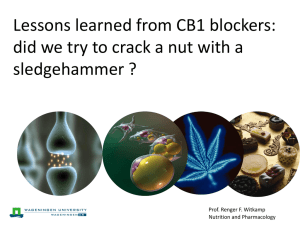

![Shark Electrosense: physiology and circuit model []](http://s2.studylib.net/store/data/005306781_1-34d5e86294a52e9275a69716495e2e51-300x300.png)
